#instar publishing
Explore tagged Tumblr posts
Text
indie weird-fiction/SFF recommendation
hey remember how about a month ago i found ARCs of these three books in a "free" shed at my town dump
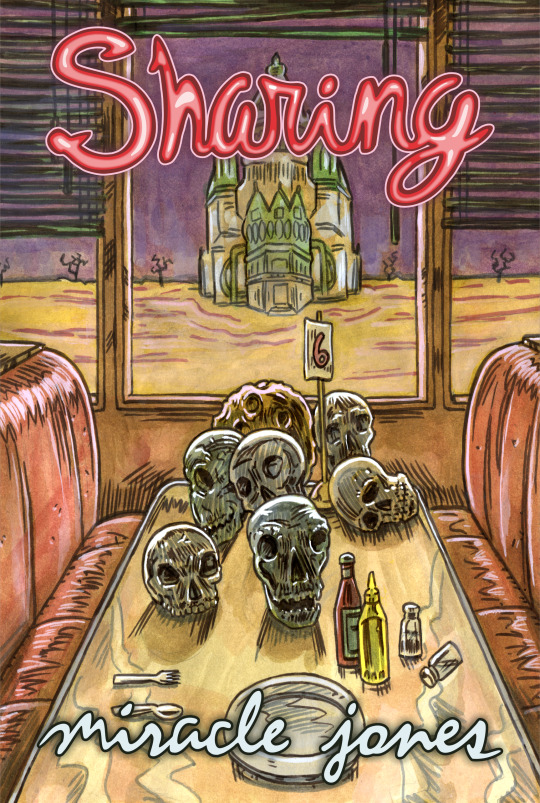
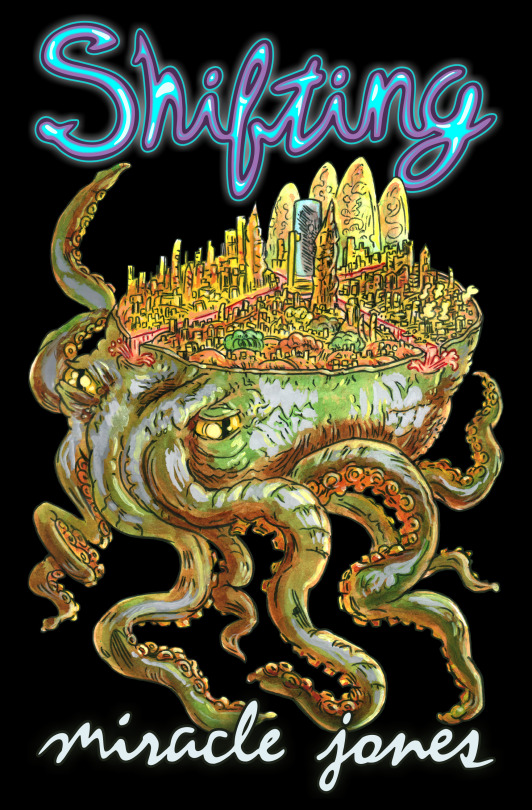
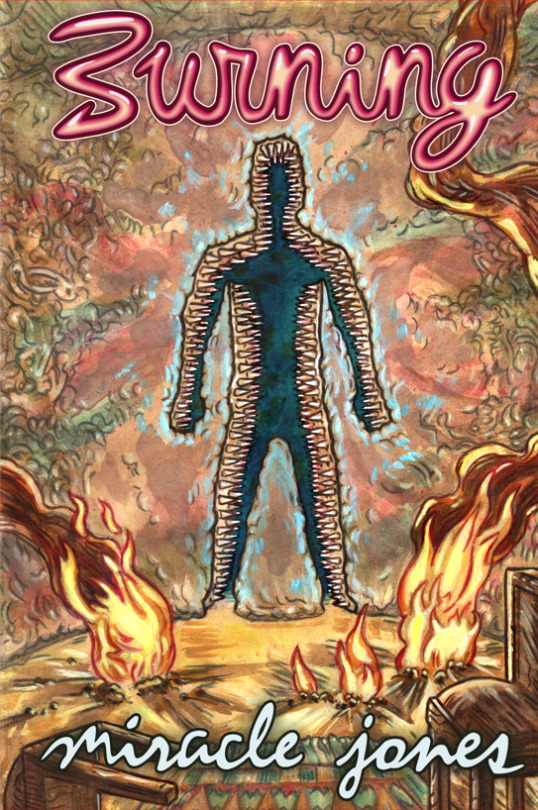
and i picked them up because the back copy really piqued my interest & i thought "okay they're free. let's try it. if the first one sucks i'll bring them all back"
well i am happy to report they extremely did not suck. in fact i absolutely adored them & am now very very invested in this ongoing story (planned as a series of 7, supposedly the 4th is coming out next year). i don't know how much the ARCs differ from the published books - which are available here from the publisher - & i will say that the ARCs were "rough" in the sense that there are typos, grammatical issues (mostly pronoun/tense problems) & very occasional missing or wrong words, but i didn't find it hampered my ability to read very much. i don't know if those are fixed or not in the final copies but i enjoyed the books so much that i don't particularly care - which is a pretty big thing for me, haha.
the blurb on the site & back copy compares them favorably to a mix of authors (William S. Burroughs, Tom Robbins, Kurt Vonnegut, David Mitchell) but those aren't really my points of reference & so not the comparisons i would make! i would heartily recommend them to fans of Clive Barker (especially if you prefer his fantasy work like Imajica & Abarat but you're still down for some seriously horrific violence/gore). pieces of Shifting also reminded me of reading Joan D. Vinge's Cat series which was very formative for me. there's a madcap element to these that definitely fits the Robbins comp but there's also real emotional depth to the characters/relationships - idk i haven't read that much Robbins but it didn't do it for me like these did.
the worldbuilding (focused on psionics, multiverses) & the characters are both incredibly unique & super memorable. i don't like to lean on lists of "representation" in book recs BUT on the other hand i don't generally connect with things that have absolutely no queerness in them, so. is there queerness here? yes! transness? debatably. is it "good rep"? totally beside the point. no. yes if you're like me & you prefer things to be messy & weird? whatever
these books are raunchy & explicit. they're hilarious. the first one horrified me & the last one made me tear up. this traumatized fantasy found family has wormed its way into my heart & i am going to be in love with a cockroach ("fairy") & a blood-sucking miniature machine planet (which is also sort of a cat?) for the rest of my life. other excellent characters include psychic plants & fungi, vicious paper people, sentient stuffed animals with semi-automatic weapons, a lesbian fire dragon & the scariest unicorns you've ever seen.
no one i know has ever heard of these books (though someone in my town owned them! who are you. where are you. why did you give them up). please, please some else read them & talk to me about them. give the first one a try - about halfway through it, i could not put it down.
3 notes
·
View notes
Text
Guess what day it is? We're back at it with a broad overview of trans-forward indie presses, looking both at some of the better known ones (Topside, Metonymy, LittlePuss) as well as a few lesser known ones (Reluctant, Doppler, Instar). We ❤️ our indie presses!
#trans fiction#trans literature#transfem#booklr#literature#books#new blog#publishing industry#publishing#indie publishing#book publishing#indie pub#indie
82 notes
·
View notes
Text
I’m not sure whether you’re into bugs other than inverts but figured I’d share with you as a fellow bug lover some rather exciting stuff I’ve been documenting over the past few months.
One afternoon while mowing the backyard I accidently almost mowed over the top of a caterpillar I hadn’t ever seen before. Now I have a small side hobby of raising caterpillars I find in my yard so I scooped this one up and secured it in my bug observation/raising box.
After some searching around I found out that the caterpillar was that of a moth species which according to the species’ database page is ‘little documented’
I took this as saying ‘hey bro, you should totally raise this one and document everything. For science.’
So that’s what I did. I’ve been in contact with the guy who runs the Lepidoptera database website for my country regarding my observations and at this point one of my photos of the caterpillar is published on the site as well as some information I’d documented regarding two whole new previously unknown food plants the species favours.
I collected the caterpillar November last year and released it as an adult female moth just a few days ago.
I’ve sent my final observation notes to the Lepidoptera guy so perhaps more of my documentation will be added to its species page particularly since I was able to document the three main life stages from caterpillar to the process of constructing the cocoon and the emergence of the adult moth.
Here are some photos for your viewing pleasure. The species in question is Anthela Acuta.
Caterpillar:

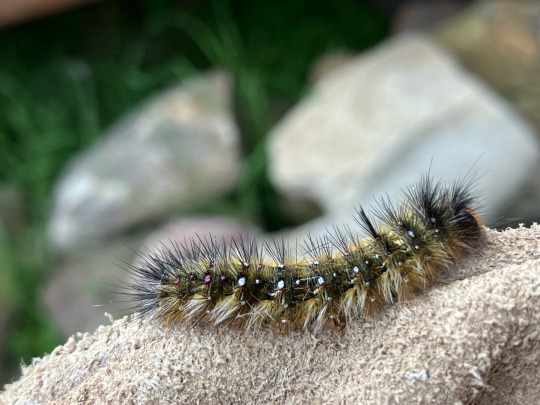
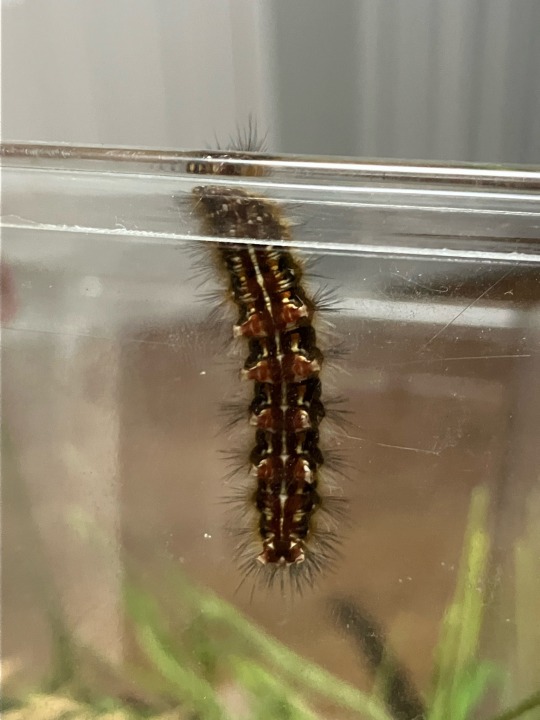
Next instar post-shed:
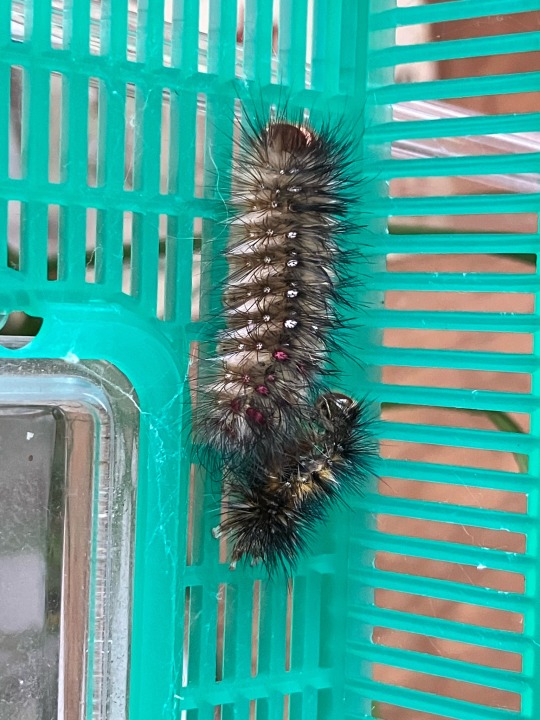
Cocoon formation:


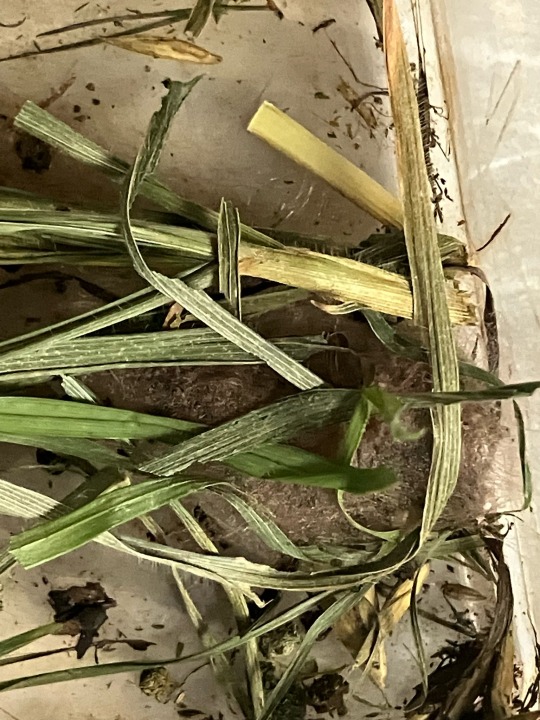
Empty cocoon and pupa shell:

Adult moth (Female):
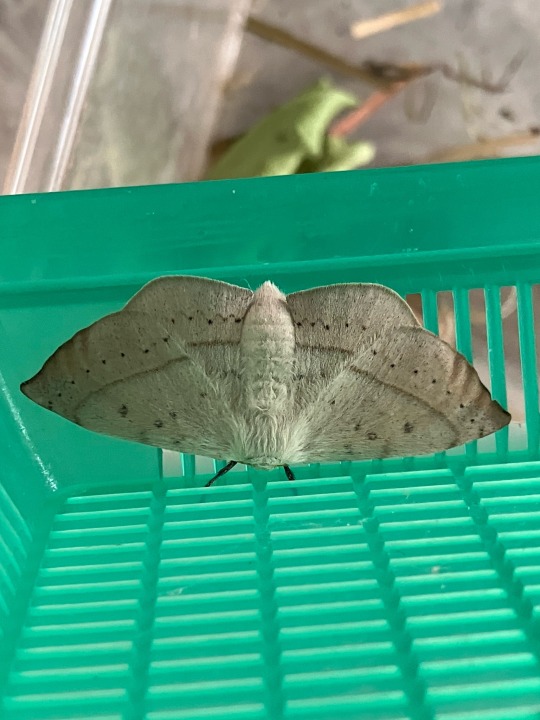
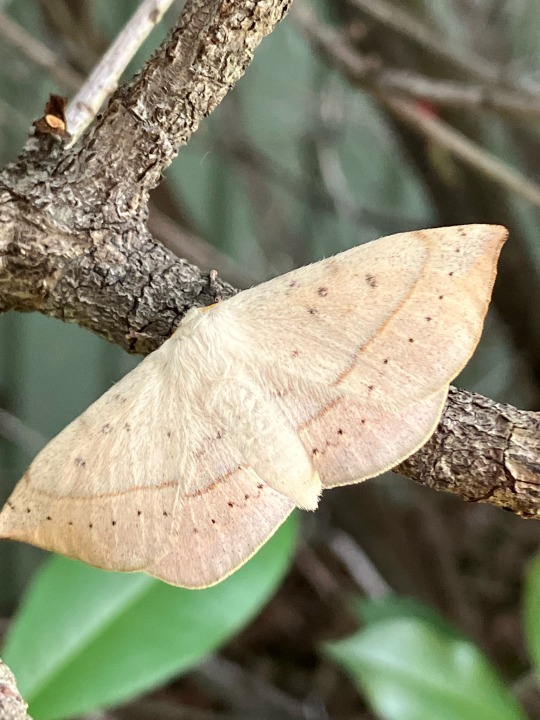
---
um this is INCREDIBLE thank you SO MUCH FOR SHARING!!! everyone follow this person's example and be a citizen scientist!!!!
168 notes
·
View notes
Text
An Excerpt From My Latest Novel...
Instar Meditations by Rebekah Jordan

From Austin Macauley Publishers, available in paperback and ebook at Amazon and Barnes & Noble

Jason emerged from the bathroom in a cloud of steam, his tanned body damp and shining from the water, hair slicked back and dark. A white towel hung low on his hips and he held it together with one lazy fist. He stepped into the room and Nora’s heart beat a little faster. He turned and went towards his suitcase and she lost track of the world around her as she focused on the flex of his muscular arms reaching for a shirt.
She moaned under her breath.
Jason’s head turned quickly and he caught her staring. “See something you like?”
Startled, Nora scrambled to pick the pen up from her lap and got back to her list. “Gross. No.”
Jason licked his juicy bottom lip and eyed her suggestively. “Gross?” he teased. “Come on, Nora. No reason to be a prude.” He turned towards her, smooth chest fully on display, and slowly lifted the white tee over his head, posing for her.
She scoffed and tried not to watch his abs tense as he moved. “I’m not a prude,” she snit. “I just…” Her mouth ran dry, all of the wetness inside of her body collecting between her thighs. She shook herself and cleared her throat. “Don’t flirt with me, OK? I’m not a bimbo from the gym or wherever you pick them up.”
Jason’s jaw dropped and he pushed his head through the shirt, popping back out with his hair a beautiful disaster. “I don’t pick up bimbos.”
Nora hummed in mock agreement. “Sure you don’t.”
He pulled the shirt down over his still-damp body, and it clung to his shoulders, showing off every line, dip, and muscle. “I don’t!” he defended. “The last chick I dated was the adjunct professor of English Literature at Georgetown.” He crossed his arms and cocked an eyebrow, waiting to be vindicated.
Nora didn’t buy it for a second. “You made that up.”
He laughed. “I did.”
His smile made her heart jump. He was too handsome, too naked, too… there. Nora blushed as he stared at her, waiting. She bit her tongue to try and stay calm. “So, what did she actually do?”
“I don’t know, I think she was a barista?”
It was Nora’s turn to laugh. “You think?” He shrugged. “I didn’t ask.”
Unsurprised, she set her notebook down and scooted towards him, creeping slowly over the bed. She leaned over her crossed legs and narrowed her eyes at him, glaring. “So... how is that dating?”
Trying to hide a smile, he pursed his lips, making deep dimples pop on either side of his upper lip. “I say date,” he explained cautiously, “but I mean-”
“Fucked and left?”
His jaw dropped and green eyes went wide. “You’re awfully judgemental, Ms. Hammond. When’s the last time you got any?”
She stammered to answer, cheeks burning, pulse racing. “It’s… it’s been a while.”
Long legs carried him to the foot of the bed and she could smell the heat beating off of him.
“A long while,” he said, voice dropping to a deep whisper.
She swallowed hard as he leaned down, terror and arousal flooding her system. She held her breath, afraid yet praying that he would drop down and grab her, lift her up into his arms, and fold her over as his tongue pressed into her mouth. “You’re so rude,” she breathed, unable to put any force behind it.
He chuckled smugly. “Hey, you started this…” Dark lashes closed slowly, brushing over his freckled cheek. He bent down, set his hands on the mattress, took a breath-
A loud crash from outside broke the moment, and both agents jumped to their feet, rushing over to the window.
Jason reached the camera first and zoomed in, checking on the rooms across the way. “Nothing,” he said finally, “just a dog.”
Nora noted the time in the log and turned her back to the window, crossing her arms and ankles as she perched on the edge of the desk, annoyed. “This is so fucking boring.”
Leaning over, Jason shot her a wink that could turn a desert into a rainforest. “I know a way to make it less boring…” His eyes trailed down to her mouth and his tongue shot out to lick at his cracked lips.
Nora exhaled loudly and growled. “Put that tongue away, sir,” she warned, “or I’ll shoot it off.”


Full Novel Available in paperback and ebook at Amazon and Barnes & Noble
Check out my other original works.
Subscribe to Patreon for exclusive short stories and behind-the-scenes content

19 notes
·
View notes
Text
Thoracic and abdominal outgrowths in early pterygotes: a clue to the common ancestor of winged insects?
Published 12th December 2023
New features from the palaeodictyopteran larvae of several different instars ,fossil specimens from the late Carboniferous at Piesberg in Germany, representing a newly described species, Katosaxoniapteron brauneri, proposed to live a aquatic or semi-aquatic lifestyle and providing possible indication for the early evolution of the ancestors of winged insects.

Larval exuviae of various instars of Katosaxoniapteron brauneri and holotype material(A)

Prothoracic lobes and meso- and metathoracic wing pads of exuviae of larvae of Katosaxoniapteron brauneri

Katosaxoniapteron brauneri gen middle instar larva reconstruction
Source:
2 notes
·
View notes
Note
1, 3, 5, 9 for ao3 wrapped!!!
So many! Ok, let's get to it.
How many words have you written this year? I'm going to fudge a little and go with "how many words have I published this year" because life is too short to spend time worrying about which of my WIPs I worked on in 2022. In 2023 I published 39,153 words on Ao3.
3. What work are you most proud of (regardless of kudos/hits)? The Bronze Age, of course! I first got the idea for that fucker nearly two entire years ago. The brainstorming! The research! The editing and rewrites! And I think I actually said something with it, you know? About Andy, and her life, and her future. What a life like hers might look like. I haven't been writing fic all that long (just since fall 2021) and I never imagined I could pull off something like this until I actually did it. (Not just the length - it took me a while to feel like I could write Andy even in short fics, because she's so far outside human comprehension.)
5. What work of yours got more feedback than you expected? I was kind of bummed about the level of engagement with The Bronze Age, so when I posted First Instar I tried to keep my expectations modest. Non-kaysanova fics get much less of a response, and First Instar is gen and Nile POV. But it got so much love! And several of the comments were specifically about things I'd done differently from popular fanon, which I'd been worried about getting pushback on. So that was very gratifying and affirming.
9. Favorite pairing you wrote for this year? I pretty much only write canon-compliant Old Guard fic, which has a limited number of pairings. But in the Bronze Age I got to throw in a bit of Andy/Quynh/Lykon, and that was a ton of fun. Of course, there's very little canon characterization of Quynh and none of Lykon, and basically nothing showing how the three of them interact, so there's a lot of freedom there. I really enjoyed it and I love how it turned out.
Fic writers year in review questions
2 notes
·
View notes
Text
Comment le phasme Ramulus mikado, un insecte qui ne vole pas, fait-il pour disperser ses œufs sur de longues distances ?
See on Scoop.it - EntomoNews
Phylogeographical evidence for historical long-distance dispersal in the flightless stick insect Ramulus mikado
Kenji Suetsugu et al. Published:11 October 2023
[Image] (a) The female adult of the stick insect Ramulus mikado. (b) The brown-eared bulbul (Hypsipetes amaurotis) feeding R. mikado to its chick. (c) H. amaurotis faecal pellets containing intact Ramulus mikado eggs. (d) Intact Ramulus mikado eggs recovered from H. amaurotis faeces. (e) First instar nymph of R. mikado hatched from the excreted egg. Scale bars: 50 mm (a), 100 mm (b) and 2 mm (c–e).
-------
NDÉ
Traduction d'après DeepL
L'étude de la manière dont les organismes surmontent les obstacles géographiques à la dispersion est une question fondamentale en biologie. Les événements de dispersion passive à longue distance, bien que peu fréquents et imprévisibles, ont un impact considérable sur l'expansion des aires de répartition des espèces.
Malgré des capacités de dispersion active limitées, de nombreuses espèces de "phasmes-bâtons" ont de vastes aires de répartition, ce qui indique que la dispersion passive sur de longues distances est vitale pour leur distribution. Un mode potentiel de dispersion passive chez les "phasmes-bâtons" est le stade de l'œuf dans les tubes digestifs aviaires, comme le suggèrent des preuves expérimentales. Cependant, la détection de tels événements dans des conditions naturelles est difficile en raison de leur rareté.
Par conséquent, afin d'évaluer indirectement le potentiel de dispersion aviaire historique, nous avons examiné la structure génétique des populations de Ramulus mikado, un "phasme-bâton" qui ne vole pas, à travers le Japon, sur la base d'une approche moléculaire à multiples facettes [haplotypes de la sous-unité I de la cytochrome oxydase (COI), marqueurs de répétitions de séquences simples nucléaires et polymorphismes de nucléotides simples à l'échelle du génome].
Par la suite, nous avons identifié des modèles phylogéographiques uniques, y compris la découverte de génotypes COI identiques sur des distances considérables, ce qui corrobore la notion de dispersion génotypique passive sur de longues distances.
Dans l'ensemble, toutes les données moléculaires ont révélé une différenciation génétique faible et généralement non significative entre les populations, avec des génotypes identiques ou très similaires dans des populations éloignées.
Nous proposons que la dispersion sur de longues distances facilitée par les oiseaux soit l'explication plausible du modèle phylogéographique unique observé chez cet insecte à bâtonnets qui ne vole pas.
Sur le site de l'Université
→ Death is only the beginning: Birds disperse eaten insects’ eggs | Research at Kobe, Kobe University, October 11, 2023 https://www.kobe-u.ac.jp/research_at_kobe_en/NEWS/news/2023_10_11_01.html
0 notes
Text
Homerus quidem in formis quibus traditum fuerat.
Hellenisticae aetatis poeta praestantissimus, etiam theoricus, Callimachus. Inter 320/15 et 240 aCn vixit, ille Alexandrinus poeta fuit, qui plurimum in poesi Romana valuit. Auctor plurium operum, fautor poeticorum in formali elegantia fundatus est per assiduum laborem limae, saporem mythologiae et eruditionis, brevitatem operis ac pretiositatem electionum linguisticarum - sticorum et stylisticorum. Nam haec styli sermonis Callimaco in antipodis Homericorum est productionis, quae simplicitatis et elegantiae praeceptis non responderet quibus credidit. Apud Calli- varium epici poematis lucem vidit, definitum per diminutivum epos, epil- ticum breve, perquam exquisitum carmen, cum argumento erotico-mythologico, quod erat ex marginali, undeveloped mythologicum episodium. prior epica vel tragica productio.
Ad Homeri carminum structuram reditio occurrit apud Apollonium Rhodium, qui Argonautas brevitatis, et elegantiae ac lenitatis aetatis Callimachi principia fidelem composuit.
Narratio omnino linearis est. Apollonius in quatuor libris fabulam narrat de Jasone qui Colchos iturus est ad quaerendum vellus aureum. Colligit igitur optimos Graecos heroas et fabricat navem, primam in historia humana, cui nomen Argoa ponit, unde nomen Argo nauti. Auxilio Medeae, maga quae cum eo incidit, heros succedet. Duo Homeri poemata summat opus: in duobus primis libris Argonautarum iter ad Odysseam refert, heroica facta de expugnatione Aurei Velleris, in duobus sequentibus libris, originem in Iliade reperimus. Sub hac autem linearitate elaborata triangulatio temporalis iacet, in qua praeteriti fabulae, prae-tragoiae, secant. sentit ubi poeta vivit et futura vaticinia. Haec continuam perspectivae mutationem generat, in qua originalis temporis notio iter facit, ut miscetur historiae et fabulae. Connexio inter varios planorum temporalium inprimis obtinetur per aetiologiam, id est explicationem originum vel causarum (aitionem Graece causam significat). Sic superatur temporis notio Homerica ;
marginalis, OGOSOXIGE
Ulixes cantu Sirenum resistens, vas rubrum instar, saeculi V aCn, Londinii, Musei Britannici.
in Homeri codicibus erat tempus "absolutum" praeteritum, nullo possibili congressu cum praesenti immersum; in carmine autem Apollonii, omnis res praesentis iustificationem et explicationem invenit in historia mythica, praecise per artem etiologicam, et fabula continenter se transfert in praesens historicum. Integrum carmen, etiam ex parte spatii sibi concessae, est fabula amoris inter Iasonem et Medeam, in qua omnino Alexandrina eros conceptio emergit sicut passio humana eminenter, quae fabulas ad mensuras reducit. cotidianae vitae affectus et realitatis modum describit simulque eorum evolutionem psychologicam maxime attentam. In his omnibus sentimus praesentiam exemplorum non solum epicorum, sed etiam theatricorum pertinentium
Apollonii carmen ingentem vim habebit ad productionem latinam, inducens cogitationem suam de necessitudine inter fabulas et historiam, inter poeticam et vitam cotidianam, inter eruditionem et affectionum descriptionem. Praecipue studium erit studere quomodo elementum subiectivum, sicut fabula amatoria in suis psychologicis implicationibus, locum suum invenit in paginis narrationis natura sua obiectiva, qualis est epica.
Tabella concessa ab Publisher ad personalem usum Prof.ssa Orrú Maria Rosa - cod.fisc. RROMRS55L62E464F
0 notes
Link
Huge congrats to all the SPD authors studding the 2019 Lammy Awards finalist lists!!!!
#future tense books#instar books#tarpaulin sky press#black lawrence press#ahsahta press#book*hug press#nomadic press#timeless infinite light#ugly duckling presse#metonymy press#nightboat books#lammys#lgbtq#small press publishing
8 notes
·
View notes
Photo

Algal Doom
Widely-distributed globally, the southern house mosquito, Culex quinquefasciatus, is an important vector for viruses affecting animals and humans. Its larvae feed on a wide range of microorganisms, making them highly adaptable, but some foods can be harmful. While monitoring mosquitoes in artificial pools of stagnant water, scientists in Argentina noticed that larvae were absent from a container filled with bright green microalgae, later identified as Neochloris aquatica. In laboratory tests, female mosquitoes preferred to lay eggs in water containing the microalgae, but most of their offspring died. Even older, second-instar larvae suffered: pictured three days after starting a new diet, larvae provided only with microalgae (middle), or even a mixture of microalgae and fish food (right), were considerably smaller than those fed fish food alone (left), and struggled to complete their development. Attractive to egg-laying females yet harmful to larval development, N. aquatica could inspire new tools for biological control.
Written by Emmanuelle Briolat
Image by M. Florencia Gil and colleagues
Instituto de Investigaciones en Biodiversidad y Biotecnología (INBIOTEC—CONICET); Fundación para Investigaciones Biológicas Aplicadas (FIBA), Mar del Plata, Argentina
Image originally published with a Creative Commons Attribution 4.0 International (CC BY 4.0)
Published in PLOS Neglected Tropical Diseases, December 2021
You can also follow BPoD on Instagram, Twitter and Facebook
13 notes
·
View notes
Text
Masterlist
updated 3/5/23
hello everyone! i thought i’d make a masterlist since i now have a few works on here!! this will be updated as i publish things and as always, everything is published on my ao3 too!!
as of right now, i’m not going to be putting my headcanons on here. however, they should still be under the tag #my writing
click here to be added to my taglist!
key: smut 🔥, fluff 🌸, angst ⚡, crack 😂, steam (almost smut) 💦, * indicates gender neutral reader
the mandalorian
din djarin
You Deserve It 🔥
origins of trust 💦 🔥
ch. 1, ch. 2,
paz vizla
Safe, Secure, and Warm 🌸 (clan leader!au)
cobb vanth
pretty girl 🔥
daddy issues 🔥
ch. 1,
boba fett
sweeter than expected 🔥 🌸 (a/b/o dynamics)
blurbies:
Boba Fett x reader x Din Djarin 💦 🔥
pt. 1, pt. 2,
star wars
a deo et rege (sith!codywan x reader) 🔥
pt. 1, pt. 2, pt. 3, pt. 4, pt.5,
darth maul
fulminis instar 🔥
pt. 1, pt. 2,
Salvatore in progress!!
jangobi (jango fett x obi-wan kenobi)
Desperate Measures 🌸 ⚡
pt. 1, pt. 2,
keep lying (to me) 🌸 ⚡
ch. 1, ch. 2, ch. 3,
star wars: the clone wars
general
The TILF Awards 😂
pt. 1, pt. 2
If You Give a Fives a Bottle of Vodka 😂
commander wolffe
Knight in Tested Armor 🌸 ⚡
ch. 1, ch. 2, ch. 3,
Lacy, Racy 💦
Moments Like These 🌸*
arc trooper echo
Tied Up 🔥*
captain rex
Tease 💦*
Delight 🔥*
arc/clone trooper jesse
Nobody 🔥
codywan (commander cody x obi-wan kenobi)
Foul Mouth 🔥
Mandalorian Elegy 🌸 ⚡
ch. 1, ch. 2,
falling into your ocean eyes ⚡
anakin skywalker
(not the) bad guy, duh 🌸 ⚡*
commander fox x riyo chuchi
Senatorial Issue 🌸
Senatorial Solutions 🌸
Foxiyo Week 2020/21 ⚡ 🌸
pt. 1, pt. 2, pt. 3, pt. 4
arc trooper fives
The “I love you” Debate 🌸 😂*
commander cody
Sweatpants Season 💦*
multi
Beach Craze 🌸 (Hardcase x reader x Jesse)
the thot collection 🔥
Commander Wolffe, x
Echo
Commander Blitz
386 notes
·
View notes
Text
Lupine Publishers | Model Development for Life Cycle Assessment of Rice Yellow Stem Borer under Rising Temperature Scenarios
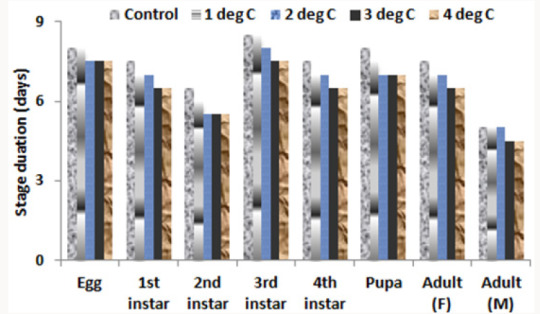
Lupine Publishers | Agriculture Open Access Journal
Abstract
A simple model was developed using Fortran Simulation Translator to study the influence of increased temperature on duration of various life cycle phases of yellow stem borer (YSB) in Bangladesh environment. Model was primarily based on Growing Degree Day concept, by also including cardinal temperatures sensitive for specific growing stages of YSB. After successful calibration and validation of the model, it was taken for climate change (only temperature rise considered in the present study) impact analysis on the growing cycle of YSB. Temperature increase values of 1, 2, 3 and 4 oC were considered and compared with the Control (no temperature rise), by using historic weather of representative locations in eight Divisions of Bangladesh. Differential spatial response in the life cycle of YSB under various temperature rise treatments was noticed, and in general the growing cycle hastened with the rising temperature. The life cycle of YSB is likely to be reduced by about 2 days for every degree celcius rise in temperature, while averaged over locations. This means that there will be 2.0-2.5 additional generations of YSB in pre-monsoon season about 2.9-3.2 in wet season of Bangladesh. There is a need to include the phenology module developed in subsequent design of population dynamics model for YSB.
Keywords: Model; Growing degree days; Yellow stem borer; Life cycle assessment; Temperature rise
Introduction
Yellow stem borer (YSB) is the most destructive and widely distributed insect-pest of rice. It causes dead heart or white head, depending on infestation time and significantly reduces rice yields by 5-10% and even up to 60% under localized outbreak conditions [1]. It can grow in places having temperature >12 oC and annual rainfall around 1000mm. Generally, temperature and high relative humidity (RH) in the evening favors stem borer growth and development [2]. The female moth oviposits from 1900 to 2200hr in summer, 1800 to 2000 hr in spring and autumn, and deposits one egg mass in a night and up to five nights after emergence. Optimum temperature is 29 oC having 90% RH for maximum number of eggs deposition. Optimum temperature for egg hatching is 24-29 oC with 90-100% RH. Larvae die at 35 oC and hatching is severely reduced when RH goes to below 70% [1]. Larvae can�t molt at 12 oC or below and they die. The last instar larvae can survive unfavorable growth condition as diapauses, which is broken by rainfall or flooding. In multiple rice cropping, no diapauses takes place. The pupal period can last for 9-12 days and the threshold temperature for its development is 15-16oC.
The number of generations in a year depends on temperature, rainfall and the availability of host [1]. The occurrence of the pest is generally the highest in wet season [3]. Since there are many stem borer species, the average life cycle of rice stem borers varies from 42-83 days [4], depending on growing conditions. This implies that heterogeneous population can be found in the same rice field. Manikandan [5] also reported that development time by different phases of YSB decreases with higher temperature and thus increased population likely in future at early growth stages of rice crop. However, no such data is available in Bangladesh. Keeping the acute problem of YSB in Bangladesh, the present study was undertaken to develop a simple phenology-based) model to assess the life cycle of YSB in two major growing seasons of rice and subsequent taking it to evaluate the effect of rising temperature on growth cycle of rice yellow stem borer in representative locations of eight Divisions of Bangladesh.
Materials and Methods
Model description
Model for assessing the phenology of yellow stem borer was written in Fortran Simulation Translator and the compiler used is FSTWin 4.12 [6]. This model will subsequently be used to develop population dynamics model for YSB in rice-based cropping systems prevalent in Bangladesh. Growing degree days (GDD) concept was used for this purpose, with base temperature assumed as 15 degree Celsius, below which growth and development activity in the life cycle of YSB does not take place. Each day, average temperature (mean of maximum and minimum temperatures) minus the base temperature is integrated over the growing cycle, and subsequently the development stage is achieved when critical value for attainment of a particular stage is crossed.
In the INITIAL phase, the GDD is taken as zero, which is read one time during running of the model
INCON GDDI, initial value of GDD = 0.
In the DYNAMIC phase, the program is executed daily till the FINISH Condition is achieved.
DAS, days after start of simulation = INTGRL (ZERO, RDAS)
PARAM RDAS, day increment rate = 1.
The development stage can be expressed in development stage (0-1), but in the present study not used for development stage identification, which we will use in further design of population dynamics model in coming times.
DVS, development stage = INTGRL (ZERO, DVR)
DVR, rate of development stage increase, Arbitrary Function Generator- a well defined FST function=AFGEN (DVRT, DAVTMP)
Since the age of male is relatively lower than the age of the female, so the computation is done separately as indicated below:
*FOR FEMALE
FUNCTION DVRT = -10.,0., 0.,0.,15.,0.,35.,0.03325,40.,0.0415
*FOR MALE
FUNCTION DVRT = -10.,0., 0.,0.,15.,0.,35.,0.0342,40.,0.0426
Base temperature below which the activities do not take place, degree celcius, is given as under:
PARAM TBASE=15.
Reading of weather data, on daily time step, is read through external file, as per well defined format for FST compiler, as given below:
WEATHER WTRDIR='c:\WEATHER\';CNTR=' GAZI';ISTN=1;IYEAR= 200
Where, various climatic elements are used as below:
RDD is solar radiation in J/m2/day
DTR = RDD
TMMX is daily maximum temperature; COTEMP is the climate change, temperature rise switch for evaluating the impact of temperature rise on the phenological development of the life cycle of YSB. TMMN is daily minimum temperature.
DTMAX = TMMX+COTEMP
DTMIN = TMMN+COTEMP
DAVTMP, average temperature (derived parameter) = 0.5* (DTMAX + DTMIN)
DDTMP, day time average temperature, derived parameter = DTMAX - 0.25* (DTMAX-DTMIN)
COTEMP is temperature rise/fall switch
PARAM COTEMP = 0.
DTEFF, effective temperature after deducting the base temperature = AMAX1(0., DAVTMP-TBASE)
SVP, is saturated vapor pressure in mbar, calculated from temperature (derived value)
SVP = 6.11*EXP (17.4*DAVTMP/(DAVTMP+239.1))/10.
VP is Actual vapor Pressure, mbar, an input for running of the modelAVP = VP
AVP = VP
RH is relative humidity, expressed in %, derived from the vapor pressure as below:
RH = AVP/SVP*100.
In the present study, only temperature and relative humidity effects are undertaken for computation of the phonological stages of the life cycle of YSB, although we have described the other climatic elements as part of the FST compiler, but the other parameters will also be used in deriving the population dynamics model, which we will take up in later course of time.
Since the development stages of YSB are influenced by relative humidity also, so we have to introduce the correction factor for including the effect of humidity, as below:
DAVTMPCF, RH induced temperature correction = DAVTMP*CFRH
TMPEFF=DAVTMPCF-TBASE
CFRH is the Correction Factor for relative humidity for judging temperature is computed as below: i.e. during hatching (CFRHH) and larva formation (CFRHL) stages, computed as below:
CFRH, correction factor for RH=INSW (GDD-EGHATCH, CFRHH, DUM11)
DUM11=INSW (GDD-979.9,CFRHL,1.)
Where INSW is FST Function, if GDD<979.9, then CFRHHD is taken and otherwise DUM11
CFRHH=AFGEN (CFRHHT, RH)
CFRHL=AFGEN (CFRHLT, RH)
FUNCTION CFRHHT=50.,0.9,60.,0.9,75.,1.,90.,1.1
FUNCTION CFRHLT=50.,0.95,60.,0.95,75.,1.,90.,1.05
WDS, wind speed in m/sec = WN
RRAIN, daily rainfall in mm = RAIN
TRAIN, total rainfall in mm = INTGRL (ZERO, RRAIN)
GDD is growing degree days, expressed in degree Celsius-days, is calculated as below:
GDD=INTGRL (GDDI, TMPEFF)
On the basis of literature search from the published literature, the growing degree days for various stages were computed and used in development of the model, and is described as below:
EGHATCH is the thermal degree days requirement for egg hatch, is as below:
PARAM EGHATCH=119.7
INSTAR1 is thermal degree days for end of first instar 1 stage
PARAM INSTAR1=224.9
INSTAR2 is thermal degree days for end of second instar stage
PARAM INSTAR2=317.0
INSTAR3 is thermal degree days for end of third instar stage
PARAM INSTAR3=438.7
INSTAR4 is thermal degree days for end of fourth instar (larva) stage
PARAM INSTAR4=550.3
PUPA, is thermal degree days for end of pupa stage
PARAM PUPA=662.452
ADULT LONGIVITY is thermal degree days for end of adult longevity, which is different for male/female, For Male=741.484 and Female=773.538, depending upon the defined parameter SEX
ADULT=INSW (SEX-1.05, FEMALE, MALE)
SEX=1. For female and 2. For male
PARAM SEX=2.
PARAM MALE, growing degree days for male = 741.484
PARAM FEMALE, growing degree day for female = 773.538
Critical temperature above which the egg hatching stops is defined as below:
DEATH=REAAND (EGHATCH-GDD, DTMAX-40.)
HATMI, minimum temperature below which the Hatching stops, is defined as below
PARAM HATMIN=15.
DEATH1=REAAND (EGHATCH-GDD, HATMIN-DTMIN)
LATMIN, minimum temperature below which larval growing stages stop, and is given as under:
PARAM LATMIN=12.
DEATH2=INSW (GDD-EGHATCH,0.,REAAND(INSTAR4-GDD,LATMIN- DTMIN))
REAAND is FST Function, which will be 1 when both the variables within parenthesis are greater than zero; otherwise the value will be 0.
Duration of various stages is computed as below:
EGHATCHD is egg hatch duration, in days and computed as below:
EGHATCHD=INTGRL (ZERO, DUM1)
DUM1=INSW (EGHATCH-GDD,0.,1.)
INSTAR1D is INSTAR1 Termination Day
INSTAR1D=INTGRL (ZERO, DUM2)
DUM2=INSW (INSTAR1-GDD, 0.,1.)
INSTAR2D is INSTAR2 Termination Day
INSTAR2D=INTGRL (ZERO, DUM3)
DUM3=INSW (INSTAR2-GDD, 0.,1.)
INSTAR3D is INSTAR3 Termination Day
INSTAR3D=INTGRL (ZERO, DUM4)
DUM4=INSW (INSTAR3-GDD, 0.,1.)
INSTAR4D is INSTAR4 Termination Day
INSTAR4D=INTGRL (ZERO, DUM5)
DUM5=INSW (INSTAR4-GDD, 0.,1.)
PUPAD is PUPA Stage Termination Day
PUPAD=INTGRL (ZERO, DUM6)
DUM6=INSW (PUPA-GDD,0.,1.)
ADULTD is Adult Life End Day
ADULTD=INTGRL (ZERO, DUM7)
DUM7=INSW (ADULT-GDD, 0.,1.)
Stop of Run Condition is as under:
FINISH DEATH > 0.95
FINISH GDD> 775.
Integration conditions for running of the program are as under:
TIMER STTIME = 360., FINTIM = 600., DELT = 1., PRDEL = 1.
TRANSLATION_GENERAL DRIVER='EUDRIV'
PRINT DAY, DOY, DVS, RH, AVP, SVP, WDS, TRAIN, GDD, DAVTMP, DAVTMPCF, ADULTD, PUPAD
In the TERMINAL stage, the final values at the stop of model run can be written in an external file:
CALL SUBWRI (TIME, COTEMP, EGHATCHD, INSTAR1D, INSTAR2D, INSTAR3D, INSTAR4D, PUPAD, ADULTD)
END
Reruns options for evaluating the impact of temperature rise on the development stages of the YSB can be run through this given below procedure:
PARAM COTEMP=1.
END
PARAM COTEMP=2.
END
STOP
Experimental
Growing degree days for attainment of various growing stages in the life cycle of YSB were collated from the published literature in this region. The model was calibrated with 2003 weather data of Bhola district of Bangladesh against the findings of Manikandan [5] at 30 oC. After model calibration, it was subsequently taken to climate change window, temperature rise only considered in the present study. Eight divisions (Dhaka, Mymensingh, Rajshahi, Rangpur, Sylhet, Khulna, Chittagong and Barisal) of Bangladesh were taken and one representative location was chosen from each division and historic weather data of 35 years were taken for running of the model and the duration of each development stage was computed and compared amongst temperature rising conditions. In the present study, daily temperature rise from 1-4 oC were considered for two growing seasons, .com rice season i.e. premonsoon (April to June) and Aman Rice season i.e. Monsoon (late June to November) of Bangladesh.
Figure 1: Days required for completion of growth stages of rice yellow stem borer with increased temperature by 1, 2, 3 and 4 degree celcius in the growing environment of Bhola, Bangladesh.
Results and Discussion
During the test period, minimum temperature averaged 26�0.115 and maximum temperature around 31�0.32, with the average temperature around 30 oC, which was used for calibration and validation of the model, and the model performed satisfactorily well, through nice agreement between observed and simulated results (Table 1). Depending on growth stages, the percent deviations were within the limit of model errors. The application of model for specific years of Bhola district showed that the growth stages of rice yellow stem borer (YSB) were decreasing (Figure 1) by about 1.76 days per degree rise in temperature (Y=1.7X+54.6; R2=0.932). This indicated that YSB is likely to infest more rice plants in future under increased temperature conditions. Ramya [7] also reported that YSB would likely to develop faster, oviposit early and thus enhanced population build up than expected. There are reports that temperature increase by 2oC may cause 1-5 times additional life cycles of insects in a season [8].
Table 1: Validation of various growth phases (days) of rice yellow stem borer.
Results, from represented locations in the eight Divisions of Bangladesh, showed that growth stage of YSB varied depending on season (Table 2). In .com pre-monsoon season, life cycle of YSB would likely to be completed within 47-53 days, depending on locations and temperature rise from 1-4 degree celcius. Similarly in Aman wet season, it would about 45-50 days for temperature rice from 1-4 degree celcius. However, under the Control (no temperature rise) condition, it requires around 52 days for T. Aman and 55 days for .com. Our findings indicate that growth cycle of YSB is likely to decrease by 2.04 days per degree rise in temperature in the .com season and 1.70 days in T. Aman season (Figure 2). Similar results were reported by Manikandan [5]. Generally, insect population build up depends on favorable weather conditions and availability of host. So, there will be ups and downs in the peak build ups in a cropping season [9]. Although model data needs to be cautiously adopted, it clearly showed that with climate change impact the infestation of YSB would be increased, which might be cause of yield reduction, if not proper management is taken at the right time [10].
Figure 2: Total life cycle duration of yellow stem borer as influenced by temperature rise during .com and T. Aman, season (averaged over eight Divisions of Bangladesh).
Table 2: Developmental phases (in days) of rice yellow stem borer as influenced by temperature rise in different growing seasons.
Conclusion
Yellow stem borer of rice crop is a major concern in Bangladesh. Dead hearts and white heads caused by YSB significantly reduce growth and yield of rice crops, especially in .com (Pre-monsoon) and T. Aman (Monsoon) seasons. There is a need to understand the phenology i.e. life cycle assessment and population dynamics of YSB in the growing environments of Bangladesh. In the present study, a simple model, as written in Fortran Simulation Translator (FST), was developed to assess the life cycle of YSB. The model was primarily based on growing degree day�s concept, by also considering cardinal temperatures for specific phenological/ development growth stages of YSB. The model was successfully validated with the growing environment of Bhola district of Bangladesh. Subsequently, the model was taken to assess the impact of rise in temperature on life cycle of YSB in representative locations of eight Divisions of Bangladesh. The response was spatiotemporally and seasonally variable. The life cycle hastened with the rise in temperature by 1-4 degree celcius. We, in near future, plan to develop a population dynamics model for YSB and to subsequently link it with the rice growth model to evaluate the yield reductions associated with YSB infestations.
Acknowledgement
We greatly acknowledge the support of Krishi Gobeshona Foundation, Dhaka, Bangladesh in conducting this research through CRP-II project.
https://lupinepublishers.com/agriculture-journal/pdf/CIACR.MS.ID.000144.pdf
For more Lupine Publishers Open Access Journals Please visit our website: https://lupinepublishersgroup.com/
For more Agriculture Open Access Journal articles Please Click
Here: https://www.lupinepublishers.com/agriculture-journal/
To Know More About Open Access Publishers Please Click on Lupine publishers
Follow on Linkedin : https://www.linkedin.com/company/lupinepublishers
33 notes
·
View notes
Text
#1595 - Lactura sapotearum

Formerly Physicampa sapotearum, and found in Queensland and NSW. Photo by Josh Macbeth, Tambourine Mt., Queensland.
The Caterpillars of this species have two large white patches on each side of the body, inflated when the caterpillar is disturbed, which they follow up by exuding a very sticky substance. The caterpillars start off blue-grey, with two tubercles on the back of each segment. These bumps are yellow on most segments except in early instars when the middle two are red. Later instars are blue-grey with longitudinal yellow stripes. There are two red or yellow horns on the prothorax and at the end of the abdomen.
The caterpillars feed by day on plants in Sapotaceae, including Black Apple ( Planchonella australis ), and Yellow Boxwood ( Planchonella pohlmaniana ), and pupate in crevices of the bark of the tree in stiff white cocoons.
The adult moths have a wingspan of 4cm, with red forewings and dark veins, and yellow markings at all three corners. The hindwings and abdomen are plain scarlet. The males are paler than the females.
This moth was originally described by Alexander Scott in a manuscript based on drawings by his daughters: Harriet and Helena, to be published in three volumes. Sadly he never managed to get Volume 3 printed, so the credit of first description goes to William Swainson, who reviewed the manuscript pre-publication in the 'Sydney Morning Herald' in 1851, with some brief descriptions of this and other species.
5 notes
·
View notes
Text
Ok, this might not seem too impressive to most of you, but for me... the new book, Instar Meditations, has already outperformed all of my other titles in just 10 days and is constantly climbing the amazon kindle rankings. (I still can't see sales... waiting on the publisher, but anyway). To me... these numbers are amazing.

In comparison, my other books are in the 4 millions on kindle store and over 500,000 in romance books. So... 1900 in my genre is kinda huge for me.

Basically, I'm freaking out lol
Thank you so much to everyone that has purchased a copy. Thank you to those who have recommended it to others. This is so cool and really has me itching to get back to my writing 💖💖
16 notes
·
View notes
Text
Suboptimal macronutrient ratios promote cannibalism in a generalist herbivore (Trichoplusia ni)
Published 15th July 2023
A study investigating the cause, benefits and costs of cannibalism in the herbivore caterpillar Trichoplusia ni.
Trichoplusia ni, from
https://doi.org/10.1111/een.13266
Using an artificial diet experiment with varied ratios of protein and carbohydrates, researchers studied cannibalistic behaviours of Trichoplusia ni from instar to pupation and measured survival among cannibals and non-cannibals.
Caterpillars in high carbohydrate and low protein cannibalised 20% more than the optimum control diet, whereas herbivores in high protein and low carbohydrate cannibalised 33% more than herbivores on the optimum macronutrient diet treatment. Survival of cannibals with a deficient diet was 10.4%, compared with 76.9% for cannibals with a optimal macronutrient diet.
In non-cannibals there was 98% pre-pupal mortality with a surplus carbohydrate diet and 91% pre-pupal mortality with a surplus protein diet, compared with 56% prepupal mortality with a balanced intermediate diet.
These results indicate that unbalanced macronutrient diet can promote cannibalism in insect herbivores.

Mortality rate of non-cannibal and cannibal Trichoplusia ni
Source:

0 notes
Text
Camila Cabello: Pap Pics and Stunting, a Year in Review
This chronicles most (if not all) of the instances where Camila was publicly papped from January 2018 - February 2019 (time of publication). This does not include any fan pictures or those from social media (i.e. Instagram, Twitter, etc.).
Prior to 2018, Camila has only truly been papped a handful of times. However, the frequency in which she has been snapped has grown significantly compared to the previous 6 years (2012-17) she has been in the industry.
(Note: The pap pics in 2018 began to surface in February, weeks after her debut album was released).
* = Days CC and MH are photographed together.
Feb 1st, 2018: Tokyo, Japan (Tokyo Narita Airport). Article 1.
Photo credits: Splash News (Vogue).
CC arriving at Tokyo Narita Airport.
Tokyo Narita Airport is the airport in Tokyo which deals with a majority of Tokyo's international flights.
Feb. 9th, 2018: Cabo, Mexico (beach)*. Article 2.
Photo credits: Backgrid (E!News).
These were the first public pictures of CC and MH together, they were published exclusively by E!News and featured them on a beach in Cabo.

The photos were snapped with photo credits given to Backgrid, a known celebrity pap agency or "celebrity news agency" as they call themselves. Backgrid has also snapped pictures of a number of other celebrities in Cabo in 2018 as well including Scott Disick, Guiliana Rancic, Gwyneth Paltrow, Ciara, and Heidi Klum which were all published in gossip magazines/sites (i.e. US Weekly, OK, & E!News).
Feb. 15th, 2018: London, UK. Article 3.
Photo credits: Backgrid (JustJared).
CC leaving her hotel in London after announcing her first solo tour.
Feb. 20th, 2018: London, UK (London Fashion Week). Article 4.
Photo credits: Getty Images (Vogue).
Feb. 26th, 2018: LAX 1 (airport)*. Article 5.1, Article 5.2 (video).
Photo credits: Perez/X17online (DailyMail).
In the second pap pic of the pair as they walked through LAX, again a location known to have paps more so then any other airport in the states.

In fact, in order to allow celebrities and business professionals to evade paps, avoid public terminals, and make better use of their time LAX has invested hundreds of millions of dollars in a private terminal as well as VIP services to ensure privacy and efficiency (Source 1: LAX Private Terminal, Source 2: United Airlines partners with LAX private terminal, Source 3: Delta provides anti-pap VIP service, Source 4: American Airlines partners with private helicopter service Flyblade).
Mar. 14th, 2018: LAX 2 (airport). Article 6.1, Article 6.2 (video).
Photo credits: Backgrid USA (JustJared); X17online.
CC posing in LAX for paps Part I.
Note: Sinu can also be seen with CC in the video although she isn't shown in the article.
Apr. 8th, 2018: LAX 3 (airport). Article 7.1, Article 7.2, Article 7.3 (video).
Photo credits: Backgrid USA (JustJaredJr), starzfly/Bauer-Griffin/GC Images (Billboard); X17online.
CC (and Sinu) posing in LAX for paps Part II. There are 2 sets of photos posted from this day however, the second set (non-Backgrid) were the more popular ones which made the rounds on various news and gossip sites.
Apr. 17th, 2018: West Hollywood, CA. Article 8.
Photo credits: The Image Direct (DailyMail).
CC and Sinuhe out to lunch in West Hollywood.
Apr. 18th, 2018: LAX 4 (airport). Article 9.
Photo credits: Backgrid (Vogue).
May 23rd, 2018: Beverly Hills, CA. Article 10.
Photo credits: Backgrid (TMZ)
CC and Sinu spotted post-hospitalization following the Billboard Music Awards.

June 8th, 2018: Manchester, UK. Article 11.1, Article 11.2.
Photo credits: Eammon and James Clarke (Manchester Evening News), INSTAR (JustJaredJr).
CC shopping in Manchester city centre with her mother Sinu.
June 19th, 2018: Paris, France (NRJ radio station). Article 12.
Photo credits: Backgrid (JustJared).
CC heading into NRJ radio station.
June 25th, 2018: Barcelona, Spain (airport)*. Article 13.1, Article 13.2.
Photo credits: Backgrid USA/Backgrid (JustJared, Metro).
The third pap pic of the pair overall, second set of the pair snapped by Backgrid.
Note: CC's family were also present. They were all seen walking together, taking selfies, and kissing in CC and MH's case. CC and Sofi also posed for paps.

June 26th, 2018: Barcelona, Spain (park)*. Article 14.
Photo credits: Backgrid (E!News).
The fourth time papped as a pair, third set of photos taken by Backgrid as a pair abroad.
Note: This features the photos of CC on MH's lap on a park bench sitting next to Sinu and kissing. CC also goes down a slide with MH waiting at the bottom. Very reminiscent of 2016 Hiddleswift (HS 1.1, HS 1.2) or March 2018 Nick Jonas.

July 25th, 2018: LA/Pacific Palisades, CA (L'Oreal event)*. Article 15.
Photo credits: Backgrid (DailyMail).
CC and MH leaving the L'Oreal X Camila launch party for the "Havana" makeup collection.
(This photo is the 1/2 featured with MH which is work related.)
Note: Sinu and Sofi are also partially snapped in photos from the article.

October 2nd, 2018: Venice Beach, California. Article 16.1, Article 16.2.
Photo credits: Backgrid (JustJared), (DailyMail)*.
Photos were taken of CC, MH, and Sinu strolling through Venice Beach.

October 15th, 2018: Sao Paulo, Brazil. Article 17.
Photo credits: Backgrid USA (JustJared), (DailyMail).
CC leaving a restaurant in Sao Paulo.
November 26th, 2018: Los Angeles, CA. Article 18.
Photos Credits: Backgrid USA (JustJared Jr.).
CC was snapped on the set of a music video.
December 6th, 2018: New York City, NY (Mastercard commercial)*. Article 19.1, Article 19.2, Article 19.3.
Photo Credits: Robert O'Neil/SplashNewsOnline; Backgrid USA, SplashNewsOnline (Just Jared, Just JaredJr.).
Photos of CC were taken during a shoot for a Mastercard commercial CC was filming. Prior to the shoot CC and MH were snapped strolling to a breakfast date in the DailyMail article although no photos of the date were presented in the article. Both Just Jared/Just Jared Jr. articles omitted details or photos of CC and MH together although the photos within the articles did mention the commerical she was filming and show moments from the shoot.
(This photo is the 1/2 featured with MH which is work related.)

January 31st, 2019: Hollywood, California (ArcLight movie theater)*. Article 20.1, Article 20.2, Article 20.3, Article 20.4.
Photo Credits: Roger/BACKGRID (DailyMail); Backgrid USA, SplashNewsOnline (JustJared, JustJaredJr.); Bauer-Griffin/SplashNews.com (E!News).
CC and MH snapped leaving a movie theater.

February 12th, 2019: LAX 5 (airport)*. Article 21.1, Article 21.2, Article 21.3, Article 21.4, Article 21.5 (video).
Photo Credits: Backgrid USA/BackGrid (JustJared, JustJaredJr; DailyMail; HollywoodLife); X17online.
CC and MH snapped at LAX only 2 days after the 2019 Grammys.
Note: In the video Sinu can be seen coming out of the vehicle with CC and MH at the airport, but immediately circles to the far left away from CC, MH, and their security guard opting to walk behind 2 paps and out of frame of the pictures instead.

The Rundown:
Total photo credits (21): Backgrid (16), X17online (4; first airport photos of CC and MH, 4 airport videos, all at LAX), SplashNews/SplashNewsOnline (3), Bauer-Griffin (2), Getty Images, starflyz, GC Images, The Image Direct, Eammon and James Clarke, and INSTAR.
Backgrid was credited for 16/21 of the days CC was papped from 2018 - February 2019.
The 5 days Backgrid was not given credit for any photos occurred between February 1st, 2018 - June 8th, 2018, from then through February 2019 Backgrid has had photo credits on every day CC has been papped.
7/21 of the days CC was photographed were in airports, of those 5/7 occurred at LAX. (Note: Despite frequent travels to NYC and Miami CC has not been papped once in 2018 flying into or out of JFK, LaGuardia, or MIA. In fact, the last time she appears to have been papped at any of these airports was LaGuardia in December 2014 with Dinah.)
Backgrid was the only ones who got pictures of CC 11/21 of the days and of those 5/11 included MH.
Backgrid was also given credit for 8/9 of the couple photos.
Also worth mentioning: 10/21 days CC was seen with a family member. 5/10 of those days also included MH, 4 were from June 25th, 2018 - October 2nd, 2018 and were the only 4 days CC was papped during that time period.
The news sites which consistently publish photos are the Daily Mail and Just Jared/Just Jared Jr with special recognition to E!News, rarely do other sites publish any photos.
Bonus link: Taylor Swift has also given exclusives to certain pap agencies for her PR relationships/bearding stunts. Namely The Image Direct for Hiddleston and Backgrid currently with Alwyn. Worth noting that CC and Taylor are friends and former tour mates.
273 notes
·
View notes